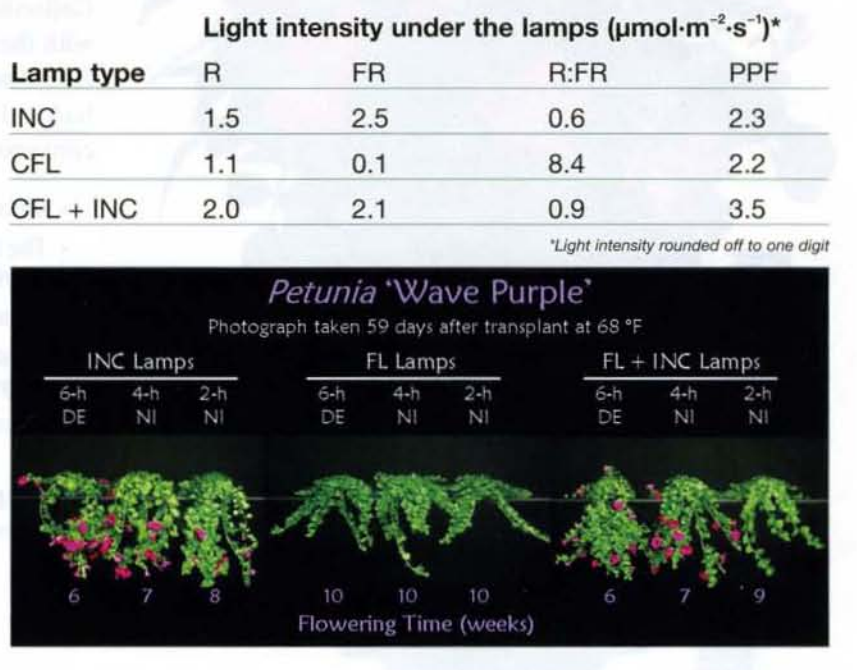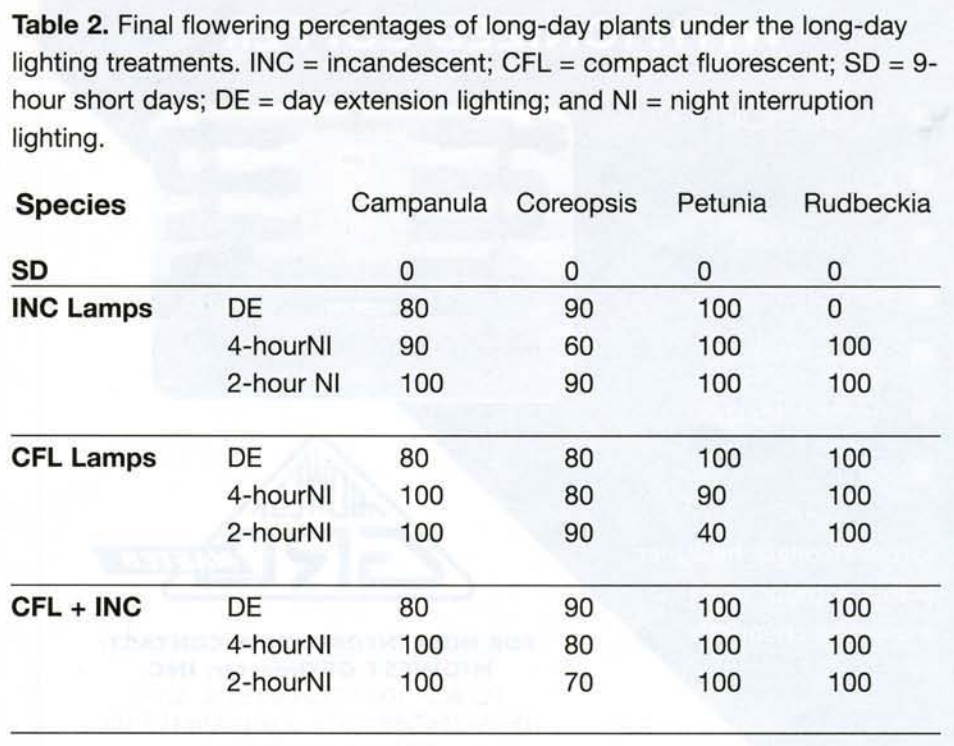
Providing long-days with CFLs
DOWNLOADMarch 24, 2009 - E. Runkle
Providing long-Days with efts By Sonau Padhye and Erik Runkle
Can compact fluorescent lamps save energy and still light your crops adequately?
In floriculture crop production, growers often use long-day photoperiod when the days are naturally shon ro promote flowering of long-day plants or to inhibit flowering of short-day plants. Replacing incandescent (INC) lamps with compaCT fluorescent (CFL) lamps has been recommended to reduce energy consumption. CFL lamps have decreased dramatically in cost, are typically 75% more energy efficient than INC lamps and can be easily retrofitted into existing INC lighting fixtures. In addition, plants grown under CFL lamps can be shorter man those under INC lamps, which can reduce the need for plant growth retardants.
However, the quality of light emitted by CFL lamps is quite different than that of INC lamps. Specifically, CFL lamps emit much less fur-red (FR) (700 to 800 nm) light than INC lamps (table 1). Therefore, the ratio of red (R) (600 to 700 nm) to FR light (R:FR) emitted by CFL lamps is substantially higher (8.4) versus that of INC lamps (0.6). When CFL lamps are used in combination with INC lamps (50% lamps of each type), the R:FR is 0.9, which is similar to the R:FR of sunlight.
Long-day photo periods can be delivered as day-extension lighting (lamps are turned on from sunset: to midnight) or night-interruption lighting (typically lamps arc turned on from 10 p.m. to 2 a.m.). Previous research has shown that when long days were provided by day extension lighting with INC or CFL lamps, flowering responses of some long-day perennials were similar. However, flowering of some long-day plants was delayed when night interruption lighting had a high R:FR, such as that under CFL lamps. The objective of this study was to quantify the efficacy of night interruption lighting on flowering of long -day plants using CFL lamps aIone or in combination with INC lamps.

Experimental set-up
Seedlings of campanula Deep Blue Clips, coreopsis Early Sunrise, petunia Wave Purple and rudbeckia Becky Orange were grown in 128-cdl plugs in growth chambers under a nine-hour photoperiod. When plugs were deemed marketable, they were transplanted into 4- or 5.5-in. pots containing a peat based medium. Plants men grew in a glass greenhouse set at 68F (2OC). Plants received a nine-hour photoperiod created by pulling blackdoth over all treatments from 5 p.m. (0 8 a.m. Nine different lighting treatments were provided by GO-wan INC and 13-watt e FL lamps, either alone or combined. Lamps were operated for six hours as a day extension (15-hour photoperiod) or for two or four hours during [he middle of the night (2- or 4-hour night interruption). The lamps were installed about 3 ft above the greenhouse benches with approximately 3 fro between each lamp. Aa a control, an additional short-day treatment (nine hour photoperiod without lighting was included.)
The data collection included flowering percentage after 15 weeks of growing, time 10 first open flowering at 68F (20C), plant height at flowering, and several environmental measurements. Here, we present results from the first set of experiments on some of the species studied.
Results and discussion
All of the plants presented here are oblig:l.lc long-day plants, and as expected, none flowered under me nine-hour short-day treatment. Rudbeckia flowered under all me lighting treatment tested (fable 2). Most (but not all) of the campanula and coreopsis flowered at about the same time. In addition, lamp type did not affect the heights of campanula and rudbeckia at flowering. Coreopsis grown under the day-extension lighting treatment with CFL lamps were 21 % shorter than the remaining treatments.
Nearly all petunia plants flowered when CFL lamps provided day extension or four-hour night interruption lighting, but only 40% of the plants flowered when provided with a two-hour night interruption (Figure I). When long days were provided by INC lamps, alone or in combination with CFL lamps, all petunias flowered. Providing day-extension lighting with CFL lamps delayed flowering of petunias by four weeks compared with then under INC lamps. Flowering of petunias was also delayed by two or three weeks when night interruption was provided by CFL lamps. Combining CFL lamps with INC lamps largely overcame this delay in flowering. The lamp type did not influence the flowering height of petunias.

Conclusion
Based on OUT results, CFL lamps can be used effectively to provide long-day photoperiods to campanula Deep Blue Clips, coreopsis Early Sunrise and rudbeckia Becky Orange. In petunia Wave Purple, flowering was inhibited or delayed under CFL lamps. However, this inhibition was overcome when CFL lamps were combined with INC lamps. Therefore, the flowering response of long-day plans to day-extension and night-interrupcion lighting provided by CFL lamps is species-specific, and may even be cultivar specific.
We are evaluating the flowering responses of additional long-day plants, a few short-day plants (to inhibit flowering) and other petunia cultivars. We caution growers against switching entirely to CFL lamps for photoperiodic lighting given the flowering delays that can occur in some crops, such as petunias. In addition, you should determine the purchase and operating costs for INC and CFL lamps to determine which option is more economical for your production. Consistent with our data, some bedding plants grower who recently switch to alternating CFL lamps with INC lamps have reported desirable results.



 Print
Print Email
Email